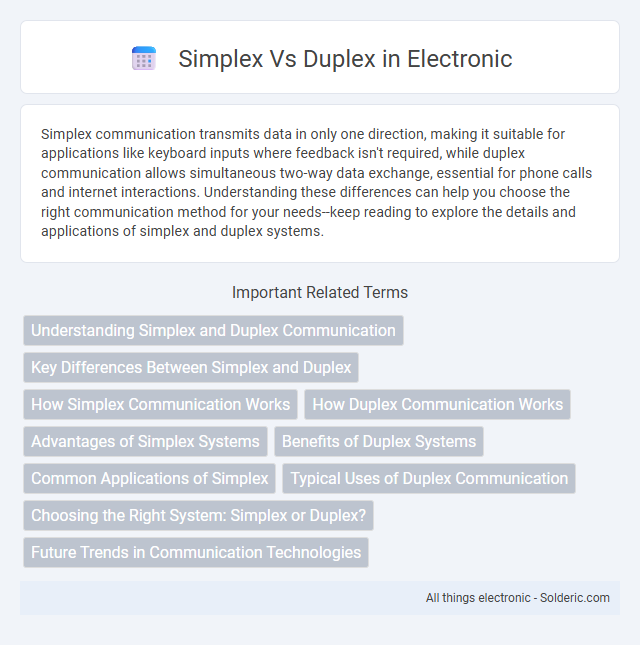Simplex communication transmits data in only one direction, making it suitable for applications like keyboard inputs where feedback isn't required, while duplex communication allows simultaneous two-way data exchange, essential for phone calls and internet interactions. Understanding these differences can help you choose the right communication method for your needs--keep reading to explore the details and applications of simplex and duplex systems.
Comparison Table
| Feature | Simplex | Duplex |
|---|---|---|
| Communication Type | One-way | Two-way |
| Data Flow | Single direction only | Both directions |
| Examples | Radio, TV Broadcast | Telephone, Internet Chat |
| Complexity | Simple | More complex |
| Cost | Lower | Higher |
| Use Case | Broadcasting where feedback isn't needed | Interactive communication |
Understanding Simplex and Duplex Communication
Simplex communication allows data to flow in only one direction, such as in a keyboard sending signals to a computer, whereas duplex communication supports two-way data exchange, enabling devices like telephones to both send and receive information simultaneously. Your choice between simplex and duplex depends on the required interaction level and data transmission needs in a specific network or system. Understanding these communication types optimizes performance in applications ranging from broadcasting to real-time video conferencing.
Key Differences Between Simplex and Duplex
Simplex communication transmits data in only one direction, making it suitable for devices like keyboards and monitors where information flows one way. Duplex communication allows two-way data transmission, either simultaneously (full duplex) or alternately (half duplex), used in devices such as telephones and walkie-talkies. The key difference lies in directional flow: simplex is unidirectional, whereas duplex supports bidirectional communication enhancing interaction and efficiency.
How Simplex Communication Works
Simplex communication transmits data in only one direction, from the sender to the receiver, without any possibility of feedback or response from the receiver. This means devices like keyboards or traditional television broadcasts send signals unidirectionally, making the communication channel straightforward and efficient for specific applications. The absence of a return path simplifies the design and reduces costs but limits interaction to a one-way flow of information.
How Duplex Communication Works
Duplex communication allows simultaneous two-way signal transmission, enabling devices to send and receive data at the same time through separate channels or frequencies. Full duplex systems use paired frequencies or wires to maintain continuous bidirectional communication, enhancing efficiency in telephony and networking applications. This contrasts with simplex communication, where data flows in only one direction, limiting interactivity and real-time response capabilities.
Advantages of Simplex Systems
Simplex systems offer advantages such as lower cost and simpler design, making them ideal for applications where only one-way communication or unidirectional data flow is required. They require less wiring and maintenance compared to duplex systems, enhancing reliability in environments with minimal interference. The straightforward operation of simplex systems ensures faster deployment and reduced complexity in network configurations.
Benefits of Duplex Systems
Duplex systems provide simultaneous two-way communication, enhancing real-time interaction and reducing transmission delays compared to simplex systems. They support higher efficiency in critical applications such as telecommunications, emergency services, and data networking by enabling continuous feedback and error correction. Duplex communication improves overall system reliability and user experience by allowing concurrent sending and receiving of information.
Common Applications of Simplex
Simplex communication is widely used in applications where data transmission is unidirectional, such as broadcast radio, television signals, and keyboard inputs to a computer. These systems rely on sending information in one direction only, ensuring efficient and straightforward communication channels without the need for response signals. Understanding the role of simplex in your technology setup can help optimize use cases where feedback or two-way interaction is unnecessary.
Typical Uses of Duplex Communication
Duplex communication is commonly used in telephone networks, video conferencing, and walkie-talkies, where simultaneous two-way interaction is essential. Full duplex allows both parties to speak and listen at the same time, improving real-time communication efficiency in applications like VoIP and online gaming. Your choice of duplex systems impacts performance in scenarios requiring immediate feedback and seamless conversational flow.
Choosing the Right System: Simplex or Duplex?
Choosing between simplex and duplex systems depends on the specific communication needs and bandwidth requirements. Simplex systems allow one-way data transmission, suitable for applications like television broadcasting where feedback is unnecessary. Duplex systems enable two-way communication, essential for interactive services such as telephone calls and internet access, offering either half-duplex (alternating transmission) or full-duplex (simultaneous transmission) modes.
Future Trends in Communication Technologies
Future trends in communication technologies emphasize increased adoption of duplex systems, enabling simultaneous two-way data transmission that enhances real-time interaction and improves network efficiency. Simplex communication remains relevant for specific applications requiring one-way data flow, such as broadcast signals and sensor networks. Your connected devices will benefit from duplex capabilities as 5G and beyond prioritize lower latency and higher bandwidth for immersive experiences and critical communications.
Simplex vs Duplex Infographic

 solderic.com
solderic.com